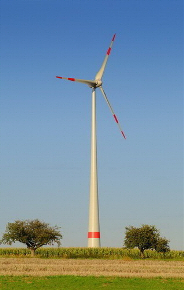
 Iranians were the first nation who used wind power to keep their windlasses running for irritation of their farms. The first practical windmills in the world were used in Sistan Province in South East of Iran to grind corn and pump water and also in grist milling and sugarcane industry.
Iranians were the first nation who used wind power to keep their windlasses running for irritation of their farms. The first practical windmills in the world were used in Sistan Province in South East of Iran to grind corn and pump water and also in grist milling and sugarcane industry.
In the recent years, the electrical power industry in Iran has experienced a remarkable growth in wind power generation and the government has developed a plan to substantially increase wind energy market share each year. The government is targeting to reach 5GW of renewable energy by 2018 much of which will come from wind as it aims to diversify the country's energy mix and reduce carbon emissions.
In this respect, in order to accomplish the government's wind power plan, there have been many types of wind turbines developed in different capacities up to 6MW in the country under the supervision of Iranian Power Ministry.
Considering the importance of structural health monitoring in wind turbines, Rasis Afzar Company has always kept pace with this need and played a key role in preparation of the Iranian National documentation for using structural health monitoring in structures of power industry especially in wind turbines.
Structural health monitoring of wind turbines is usually performed using several accelerometers and strain gages attached to the nacelle to monitor the gearbox and equipment and to measure dynamics of the wind turbine blades. Displacement and strain are usually measured to identify the location of defects.
 In this regard the following services are delivered by Monitoring Department of Rasis Afzar Company:
In this regard the following services are delivered by Monitoring Department of Rasis Afzar Company:
- Wind turbine tower and foundation Structural Health Monitoring.
- Wind turbine Vibration Monitoring and Analysis.
- Wind turbine Strain Monitoring and analysis.
- Wind turbine Condition Monitoring.
- Wind turbine Pitch Control (part of the service)
- Wind Monitoring, wind profile logging and providing wind sensors.